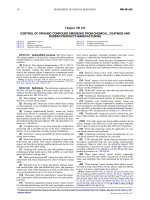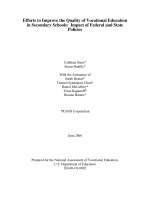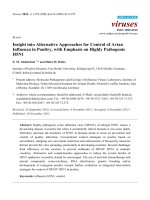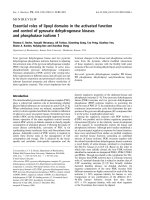End to end admission control of multiclass traffic in WCDMA mobile network and wireline differentiated services
Bạn đang xem bản rút gọn của tài liệu. Xem và tải ngay bản đầy đủ của tài liệu tại đây (1.65 MB, 130 trang )
END-TO-END ADMISSION CONTROL OF MULTICLASS
TRAFFIC IN WCDMA MOBILE NETWORK
AND WIRELINE DIFFERENTIATED SERVICES
XIAO LEI
NATIONAL UNIVERSITY OF SINGAPORE
2003
END-TO-END ADMISSION CONTROL OF MULTICLASS
TRAFFIC IN WCDMA MOBILE NETWORK
AND WIRELINE DIFFERENTIATED SERVICES
XIAO LEI
(B.Sc., Fudan University)
A THESIS SUBMITTED
FOR THE DEGREE OF MASTER OF ENGINEERING
DEPARTMENT OF ELECTRICAL & COMPUTER ENGINEERING
NATIONAL UNIVERSITY OF SINGAPORE
2003
Acknowledgements
I would like to take this opportunity to express my gratitude to all the people
who have contributed to this thesis. Foremost among them are my supervisors, Dr.
Wong Tung Chong and Dr. Chew Yong Huat. Both of them have given great guidance
and advice in my study and research. I have learned enormously from them about the
research, and as well as how to communicate with others.
I would also like to thank the other people in this project team, Nie Chun, Yao
Jianxin and Govindan Saravanan, for the helps, discussions and suggestions to my
research work.
Finally, I would like to thank my parents for their great love, encouragement
and support in my two years studies.
Contents
Summary......................................................................................................................IV
List of Figures..............................................................................................................VI
List of Tables ...............................................................................................................IX
Glossary of Symbols....................................................................................................XI
Abbreviations ...........................................................................................................XIII
Chapter 1. Introduction ............................................................................................... 1
1.1 QoS in Wireline Networks.................................................................................... 1
1.1.1 Integrated Services......................................................................................... 2
1.1.2 Differentiated Services .................................................................................. 3
1.2 QoS in Wireless Networks.................................................................................... 4
1.3 Contributions of Thesis......................................................................................... 6
1.4 Organization of Thesis.......................................................................................... 6
Chapter 2. Differentiated Services Network .............................................................. 7
2.1 Differentiated Services Architecture..................................................................... 7
2.1.1 DiffServ Network Domain............................................................................. 8
2.1.2 Per-Hop Behavior .......................................................................................... 9
2.1.3 DiffServ Network Provisioning ................................................................... 11
2.2 Admission Control.............................................................................................. 12
2.2.1 Measurement-Based CAC ........................................................................... 12
2.2.2 Resource Allocation-Based CAC ................................................................ 14
2.2.3 Hybrid CAC ................................................................................................. 15
CONTENTS
II
2.2.4 Summary...................................................................................................... 16
Chapter 3. WCDMA and UMTS............................................................................... 17
3.1 UMTS Architecture ............................................................................................ 18
3.2 WCDMA Radio Interface ................................................................................... 20
3.2.1 Spreading and Scrambling ........................................................................... 20
3.2.2 Transport and Physical Channel .................................................................. 21
3.2.3 Power Control .............................................................................................. 22
3.3 UMTS Quality of Service ................................................................................... 23
3.3.1 UMTS QoS Classes ..................................................................................... 24
3.3.2 UMTS QoS Management ............................................................................ 25
3.4 Admission Control in WCDMA ......................................................................... 26
Chapter 4. DiffServ Network Admission Control.................................................... 29
4.1 QoS Classes Mapping ......................................................................................... 29
4.2 Resource Provisioning ........................................................................................ 30
4.2.1 Equivalent Bandwidth.................................................................................. 31
4.2.2 Equivalent Bandwidth with Priorities.......................................................... 33
4.3 Admission Control Strategies ............................................................................. 34
4.3.1 Traffic Models ............................................................................................. 34
4.3.2 Bandwidth Allocation .................................................................................. 35
4.3.3 Statistical Delay Guarantee.......................................................................... 39
4.4 Single-Hop Scenario ........................................................................................... 40
4.4.1 Buffer Management ..................................................................................... 42
4.4.2 Multiclass Bandwidth Management ............................................................ 47
4.4.3 Admission Region........................................................................................ 51
4.5 Multi-Hop Scenario ............................................................................................ 53
CONTENTS
III
4.5.1 Admission Control Algorithm ..................................................................... 54
4.5.2 Simulation.................................................................................................... 55
4.6 Conclusion .......................................................................................................... 66
Chapter 5. End-to-End Admission Control.............................................................. 68
5.1 Admission Control in UMTS.............................................................................. 68
5.1.1 WCDMA Wireless Interface Admission Control ........................................ 69
5.1.2 UMTS Wireline Network Admission Control............................................. 74
5.2 End-to-End QoS Architecture............................................................................. 76
5.3 End-to-End Admission Control Strategy ............................................................ 78
5.4 End-to-End Simulation ....................................................................................... 79
5.4.1 Single-Connection without Retransmission................................................. 80
5.4.2 Single-Connection with Retransmission...................................................... 86
5.4.3 Multi-Connection with Retransmission ....................................................... 91
5.5 Admission Control in Downlink Direction......................................................... 95
5.6 End-to-End Admission Control Implementation................................................ 95
5.7 Conclusion .......................................................................................................... 96
Chapter 6. Conclusion ................................................................................................ 98
6.1 Thesis Contribution............................................................................................. 98
6.2 Future Work ...................................................................................................... 100
Appendix.................................................................................................................... 101
WCDMA Wireless Admission Region .................................................................. 101
Bibliography .............................................................................................................. 106
Summary
In this thesis, we investigate the Quality of Service (QoS) provisioning issues
of multiclass traffic across a Wideband Code Division Multiple Access (WCDMA)
mobile network and a wireline Differentiated Services (DiffServ) Internet Protocol (IP)
network, and focus on end-to-end admission control. The main objective is to propose
an effective admission control algorithm for the end-to-end delivery of multimedia
information between the mobile users and the fixed network users with specified QoS
guarantees.
We define the mapping of QoS classes between the Universal Mobile
Telecommunications Services (UMTS) and DiffServ networks according to different
QoS requirements due to the different QoS architectures in the two domains. We
propose a resource allocation and admission control scheme in DiffServ network and it
inter-works with the four QoS classes in UMTS. Through the management of
equivalent bandwidth allocation, the packet loss ratio at each router can be bounded;
with a delay bound estimation, the statistical delay control at the router can also be
obtained. Thus end-to-end packet loss ratio and statistical delay guarantee can be
achieved. We also study the effect of buffer size on the four traffic classes with
different priorities in the system.
We observe that the higher priority the traffic, the smaller the buffer size
needed to provide the loss ratio guarantee. Only when the system is close to full
utilization, the buffer size needed for a lower priority class, especially the background
SUMMARY
V
traffic with the lowest priority, increases drastically. The increase of buffer size of the
real-time traffic imposes a small increase on packet queuing delay due to its high
priority in the system. However, it can reduce the packet loss ratio significantly.
Furthermore, we apply the above scheme in end-to-end admission control, in
both the UMTS DiffServ capable wireline network and the external DiffServ IP
network. The admission region of the WCDMA cell is based on the outage probability
and the packet loss ratio of each class in the wireless channel. Three different wireless
admission region schemes, single-connection without retransmission, singleconnection with retransmissions and multi-connection with retransmissions, are
investigated. The wireless and wireline networks interact with each other in the end-toend admission control. Only if both domains have enough resources to support the new
and existing connections and the end-to-end QoS requirements can be guaranteed, then
the new connection is admitted. Simulation results show that the schemes are effective
in providing end-to-end QoS guarantees.
List of Figures
Figure 2.1: DiffServ Network Domain ........................................................................... 8
Figure 3.1: Network elements in a PLMN.................................................................... 18
Figure 3.2: UMTS QoS Architecture............................................................................ 23
Figure 4.1: Video Source Model................................................................................... 35
Figure 4.2: Single-Hop Scenario .................................................................................. 40
Figure 4.3: Voice Packet Loss Ratio vs. Buffer Size.................................................... 42
Figure 4.4: Video Packet Loss Ratio vs. Buffer Size (Video Load: 0.33).................... 43
Figure 4.5: Interactive Packet Loss Ratio vs. Buffer Size (Interactive Load: 0.33) ..... 45
Figure 4.6: Background Packet Loss Ratio vs. Buffer Size.......................................... 45
Figure 4.7: Voice and Video Packet Loss Ratio vs. Queuing Delay ............................ 46
Figure 4.8: Admission Region Examples of Scheme A ............................................... 52
Figure 4.9: Admission Region Examples of Scheme B................................................ 52
Figure 4.10: Multi-Hop Simulation Topology.............................................................. 53
Figure 4.11: Voice Packet Delay Distribution (Edge 1 - Sink 10) ............................... 58
Figure 4.12: Voice Packet Delay Distribution (Edge 1 - Sink 11) ............................... 58
Figure 4.13: Voice Packet Delay Distribution (Edge 2 - Sink 10) ............................... 59
Figure 4.14: Voice Packet Delay Distribution (Edge 2 - Sink 11) ............................... 59
Figure 4.15: Voice Packet Delay Distribution (Edge 3 - Sink 10) ............................... 60
Figure 4.16: Voice Packet Delay Distribution (Edge 3 - Sink 11) ............................... 60
Figure 4.17: Voice Packet Delay Distribution (Edge 4 - Sink 11) ............................... 61
Figure 4.18: Voice Packet Delay Distribution (Edge 5 - Sink 9) ................................. 61
LIST OF FIGURES
VII
Figure 4.19: Video Packet Delay Distribution (Edge 1 - Sink 10) ............................... 62
Figure 4.20: Video Packet Delay Distribution (Edge 1 - Sink 11) ............................... 62
Figure 4.21: Video Packet Delay Distribution (Edge 2 - Sink 10) ............................... 63
Figure 4.22: Video Packet Delay Distribution (Edge 2 - Sink 11) ............................... 63
Figure 4.23: Video Packet Delay Distribution (Edge 3 - Sink 10) ............................... 64
Figure 4.24: Video Packet Delay Distribution (Edge 3 - Sink 11) ............................... 64
Figure 4.25: Video Packet Delay Distribution (Edge 4 - Sink 11) ............................... 65
Figure 4.26: Video Packet Delay Distribution (Edge 5 - Sink 9) ................................. 65
Figure 5.1: Protocol Termination for DCH, User Plane ............................................... 74
Figure 5.2: MS-GGSN User Plane with UTRAN......................................................... 75
Figure 5.3: Simulation Topology of UMTS System..................................................... 79
Figure 5.4: End-to-End Voice Packet Delay Distribution (Cell - Sink 10) (Scheme 1)
............................................................................................................................... 84
Figure 5.5: End-to-End Voice Packet Delay Distribution (Cell - Sink 11) (Scheme 1)
............................................................................................................................... 84
Figure 5.6: End-to-End Video Packet Delay Distribution (Cell - Sink 10) (Scheme 1)
............................................................................................................................... 85
Figure 5.7: End-to-End Video Packet Delay Distribution (Cell - Sink 11) (Scheme 1)
............................................................................................................................... 85
Figure 5.8: End-to-End Voice Packet Delay Distribution (Cell - Sink 10) (Scheme 2)
............................................................................................................................... 89
Figure 5.9: End-to-End Voice Packet Delay Distribution (Cell - Sink 11) (Scheme 2)
............................................................................................................................... 89
Figure 5.10: End-to-End Video Packet Delay Distribution (Cell - Sink 10) (Scheme2)
............................................................................................................................... 90
LIST OF FIGURES
VIII
Figure 5.11: End-to-End Video Packet Delay Distribution (Cell - Sink 11) (Scheme 2)
............................................................................................................................... 90
Figure 5.12: End-to-End Voice Packet Delay Distribution (Cell - Sink 10) (Scheme 3)
............................................................................................................................... 93
Figure 5.13: End-to-End Voice Packet Delay Distribution (Cell - Sink 11) (Scheme 3)
............................................................................................................................... 93
Figure 5.14: End-to-End Video Packet Delay Distribution (Cell - Sink 10) (Scheme 3)
............................................................................................................................... 94
Figure 5.15: End-to-End Video Packet Delay Distribution (Cell - Sink 11) (Scheme 3)
............................................................................................................................... 94
Figure 5.16: End-to-End Admission Control Scheme Flow Chart............................... 96
List of Tables
Table 2.1: Assured Forwarding PHB............................................................................ 10
Table 3.1: Uplink DPDCH Data Rates ......................................................................... 22
Table 4.1: QoS Mapping between UMTS and DiffServ Network ............................... 30
Table 4.2: Traffic Models of UMTS QoS Classes in Simulation ................................. 35
Table 4.3: Comparison of Asymptotic Constant Estimation ........................................ 37
Table 4.4: Capacity Gain of Asymptotic Constant Estimation..................................... 37
Table 4.5: Simulation Parameters ................................................................................. 41
Table 4.6: Single-Hop System Utilization .................................................................... 48
Table 4.7: Single-Hop Packet Loss Ratio ..................................................................... 49
Table 4.8: Packet Loss Ratio Comparison between Scheme B and C.......................... 51
Table 4.9: Source Destination Pair ............................................................................... 53
Table 4.10: Simulation Parameters ............................................................................... 56
Table 4.11: Packet Loss Ratio and Utilization ............................................................. 57
Table 5.1: Simulation Parameters of Wireless Interface .............................................. 80
Table 5.2: Simulation Parameters of Wireline Networks ............................................. 81
Table 5.3: Wireless Interface Simulation Results (Scheme 1) ..................................... 82
Table 5.4: Wireline Network Packet Loss Ratio (Scheme 1) ....................................... 83
Table 5.5: Wireless Interface Simulation Results (Scheme 2) ..................................... 87
Table 5.6: Wireline Network Packet Loss Ratio (Scheme 2) ....................................... 88
Table 5.7: Simulation Parameters in Multi-Connection with Retransmission ............. 91
Table 5.8: Wireless Interface Simulation Results (Scheme 3) ..................................... 92
LIST OF TABLES
X
Table 5.9: Wireline Networks Simulation Results (Scheme 3) .................................... 92
Glossary of Symbols
B
Buffer size
Bj
Buffer size of jth class traffic
H
Hurst parameter of long range dependence source
I intercell
Inter-cell interference
Kj
User Number of jth class traffic
Q
Queue length in buffer
Wi
Waiting time of jth class packet
Wi
Mean waiting time of jth class packet
b
Mean burst size
eb
Equivalent bandwidth
eb j
Equivalent bandwidth of jth class traffic
eb j
k
Equivalent bandwidth of type j sources seen by type k traffic
m
Mean rate of aggregate sources
r
Transmission rate during On state of the source
γ
Asymptotic constant
γj
Asymptotic constant of jth class traffic
δ
Asymptotic decay rate
ε
Packet loss rate
α
Transition rate from On to Off state of exponential on-off source
β
Transition rate from Off to On state of exponential on-off source
GLOSSARY OF SYMBOLS
σ
Standard deviation
ρ
System utilization
ρi
Utilization of jth class traffic
ω
Shape parameter of Pareto distribution
θ
Location parameter of Pareto distribution
µ
Mean value of exponential distribution
XII
Abbreviations
AF
Assured Forwarding
ARQ
Automatic Repeat Request
ATM
Asynchronous Transfer Mode
BB
Bandwidth Broker
BCH
Broadcast Channel
BER
Bit Error Ratio
CAC
Connection Admission Control
CDE
Chernoff Dominant Eigenvalue
CDMA
Code Division Multiple Access
CN
Core Network
CPCH
Uplink Common Packet Channel
CS
Circuit-Switched
DCH
Dedicated Transport Channel
DiffServ
Differentiated Services
DPCCH
Dedicated Physical Control Channel
DPDCH
Dedicated Physical Data Channel
DS-CDMA
Direct-Sequence Code Division Multiple Access
DSCH
Downlink Shared Channel
DSCP
Differentiated Service Code Point
EB
Equivalent Bandwidth
EF
Expedited Forwarding
ABBREVIATIONS
FACH
Forward Access Channel
FBM
Fractional Brownian Motion
FDD
Frequency Division Duplex
FEC
Forward Error Correction
GGSN
Gateway GPRS Support Node
GPRS
General Packet Radio Service
GSM
Global System for Mobile Communications
GSN
GPRS Support Node
GTP
GPRS Tunneling Protocol
GTP-U
GTP for the User Plane
HLR
Home Location Register
IETF
Internet Engineering Task Force
IMS
IP Multimedia Core Network Subsystem
IntServ
Integrated Services
IP
Internet Protocol
ISDN
Integrated Services Digital Network
MAI
Multiple Access Interference
ME
Mobile Equipment
MSC
Mobile Switching Center
MT
Mobile Termination
MTU
Maximum Transfer Unit
OVSF
Orthogonal Variable Spreading Factor
PCH
Paging Channel
Policy Decision Function
PDP
Packet Data Protocol
XIV
XIV
ABBREVIATIONS
PDU
Protocol Data Unit
PHB
Per-Hop Behavior
PLMN
Public Land Mobile Network
PS
Packet-Switched
PSTN
Public Switched Telephone Network
QoS
Quality of Service
RACH
Random Access Channel
RNC
Radio Network Controller
RNS
Radio Network Subsystem
RRC
Radio Resource Control
RRM
Radio Resource Management
RSVP
Resource Reservation Setup Protocol
SBLP
Service Based Local Policy
SGSN
Serving GPRS Support Node
SIR
Signal to Interference Ratio
SNMP
Simple Network Management Protocol
SRNC
Serving RNC
TDD
Time Division Duplex
TDMA
Time Division Multiple Access
TE
Terminal Equipment
TOS
Type of Service
UDP
User Datagram Protocol
UE
User Equipment
UMTS
Universal Mobile Telecommunications Services
UTRAN
UMTS Terrestrial Radio Access Network
XV
XV
ABBREVIATIONS
VBR
Variable Bit Rate
VLR
Visitor Location Register
WCDMA
Wideband Code Division Multiple Access
XVI
XVI
Chapter 1
Introduction
Wireless personal communications and Internet are the fastest growing
segments of the telecommunication industry. Demand for high-speed wireless data and
video services is expected to overtake voice services as the wireless industry grows
and a hybrid wireless wideband CDMA/wireline Internet Protocol (IP)-based network
will be the main platform for providing multimedia services to both mobile and fixed
users.
As the end-to-end connection spans over both wireless wideband Code
Division Multiple Access (CDMA) segment in the third generation wireless system
and wireline IP-based network such as the Internet, the end-to-end Quality of Service
(QoS) architecture consists of two parts: the wireless and the wireline QoSs. This
proposed research will investigate how to interconnect a future wireless network with
the IP network for seamless end-to-end information delivery.
1.1 QoS in Wireline Networks
Quality of Service is a broad term used to describe the overall performance
experience that a user or application will receive over a wireless or wireline network.
CHAPTER 1. INTRODUCTION
2
QoS involves a broad range of technologies, architectures and protocols. Network
operators achieve end-to-end QoS by ensuring that network elements apply consistent
treatment to traffic flows as they traverse the network.
Despite the fast growth, most traffic on the Internet is still “best effort”, which
means that all packets are given the same treatment without any guarantee in regards to
the QoS parameters, such as loss ratio, delay and so on. However, with the increasing
use of the Internet for real-time services (voice, video, etc.) and non-real-time services
(data), there is a need for the Internet to provide different types of services having
different QoS requirements.
There has been much research work done in the recent years on QoS issues in
the Internet. The main QoS frameworks of interests include the Integrated Services
(IntServ) [1] with Resource Reservation Setup Protocol (RSVP) [2] and the
Differentiated Services (DiffServ) [3] which are defined by the Internet Engineering
Task Force (IETF).
1.1.1 Integrated Services
The main idea of IntServ is to provide an application with the ability to choose
its required QoS from a range of controlled options provided by the network. Its
framework developed by IETF is to provide individualized QoS guarantees to
individual application sessions. Thus it depends on the routers of the network having
the ability to control the QoS and the means of signaling the requirements. RSVP
provides the needed signaling protocol.
For the network to deliver a quantitatively specified QoS to a particular flow, it
is usually necessary to set aside certain resources (e.g., bandwidth) for that flow. RSVP
CHAPTER 1. INTRODUCTION
3
is an unidirectional control protocol that enables the QoS to be signaled and controlled.
It helps to create and maintain resource reservations on each link along the transport
path of the flow. With RSVP, the application call can signal the IP network to request
the QoS level that it needs to provide the desired performance. If the network cannot
provide the requested QoS level, the application may try a different QoS level, send
the traffic as best-effort or reject the call.
Even though it can provide good QoS support, IntServ has the problem of
scalability. This is because IntServ routers handle signaling and state management at
the flow level to provide the desired QoS. If it is implemented at the Internet core
network, it will place a huge burden on the core routers. In a very large network there
are likely to be many users in the routers with similar QoS requirements, so it is much
more efficient to use a collective approach to handle the traffic. This is performed by
the differentiated services protocol to be described in the following paragraph.
1.1.2 Differentiated Services
Differentiated Services is defined by the IETF DiffServ Working Group to
provide “relatively simple and coarse methods of providing differentiated classes of
service for Internet traffic, to support various types of applications”. The main goal is
to overcome the well-known limitations of Integrated Services and RSVP, namely, low
scalability of per-flow management in the core routers.
DiffServ distinguishes between the edge and core routers. While edge routers
process packets on the basis of a finer traffic granularity (e.g., per-flow), core routers
only distinguish among a very limited number of traffic classes. Packets belonging to a
given traffic class are identified by the bits in the DS field (a dedicated field in the
CHAPTER 1. INTRODUCTION
4
header of IPv4 and IPv6 datagrams) of the IP packet header, and served by the routers
according to a predefined per-hop behavior (PHB). In this way, traffic flows can be
aggregated into a relative small number of PHBs which can be easily handled by core
routers without scalability restrictions.
A PHB is a description of the rules a DiffServ compliant router uses to treat a
packet belonging to a particular aggregated flow. Currently, some PHBs have been
defined by the IETF, which include Assured Forwarding (AF) PHB [4] and Expedited
Forwarding (EF) PHB [5].
1.2 QoS in Wireless Networks
Wireless networks provide communications to mobile users through the use of
radio technologies, which include cellular system, cordless telephone, satellite
communication, wireless local area network, etc. Compared with wireline network, the
main advantages of wireless communications systems include: low wiring cost, rapid
deployment of network and terminal mobility.
Current cellular communication systems are mainly used for voice-oriented
services. Analog cellular systems are commonly referred to as the first generation
systems. The digital systems currently in use, such as GSM, CdmaOne (IS-95) and
US-TDMA, are second-generation systems. As for the third generation cellular
systems, they are designed for multimedia communications, which means personal
communications include not only voice, but also integrated services like image, video
and data transmission.
The QoS framework for different service requirements should also be
implemented in order to provide multimedia service capability in wireless networks.
CHAPTER 1. INTRODUCTION
5
Unfortunately, the quality of service over wireless transmission is much worse than
that in the wireline networks. This is because the wireless medium has a much higher
bit error ratio as a result of time-varying channel impairment. Wireless communication
has the channel impairments such as multipath fading, background noise and multiuser
interference. Thus it is more error-prone than that in the wireline networks. One of the
solutions to this problem is to use Forward Error Correction (FEC), but it will add to
the packet overhead and reduce the wireless channel capacity. Another alternative
approach is to use Automatic Repeat Request (ARQ), which includes three main
techniques, namely Go-Back-N, Stop and Wait and Selective Repeat. FEC is suitable
for real-time traffic such as voice and video, while ARQ is suitable for non-real-time
traffic like data. Go-Back-N ARQ is often used because of its simplicity and
efficiency. Furthermore, a combination of both ARQ and FEC is possible. Because
wireless medium is a shared medium, many users use the same channel for
communication. The multiuser interference plays an important role in the channel
performance. Since all the terminals use the wireless channel at the same frequency, a
tight and fast power control is one of the most important aspects in the cellular CDMA
systems.
While wireless communication provides the user with mobility support, it also
brings about the problems of service performance degradation and call handover. In
order to provide higher capacity, the wireless system needs to set up more microcells
architectures. It results in more frequent handovers of mobile users and higher call
blocking and dropping probability, which degrade the quality of service in the system.
CHAPTER 1. INTRODUCTION
6
1.3 Contributions of Thesis
This thesis presents and studies the admission control for a resource allocation
scheme with multiclass traffic in a DiffServ IP network. The four QoS classes of
WCDMA (UMTS) system is mapped and used as the traffic sources in the DiffServ
network.
We further extend this scheme to end-to-end admission control from the thirdgeneration wireless system (WCDMA) to the wireline (DiffServ) networks. This thesis
also investigates how to interconnect a future wireless network with the Internet for
seamless end-to-end information transmission. The simulation results show that this
scheme can satisfy both the packet loss ratio and end-to-end delay requirements for the
multiclass traffic.
1.4 Organization of Thesis
This chapter gives an overview of the QoS issues of the wireline and wireless
communication networks. Chapter 2 describes the framework of a DiffServ network
and gives a survey on the available admission control schemes. Chapter 3 introduces
the WCDMA system, Universal Mobile Telecommunications Services (UMTS) and
the wireless interface. In chapter 4, we present the DiffServ network admission scheme
proposed and its simulation results. We investigate the end-to-end admission control
scheme from the wireless network to the wireline network in chapter 5. Finally, the
thesis is concluded in chapter 6.









